Name Nell Blaine | ||
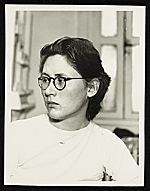 | ||
Education Richmond Professional Institute Books Nell Blaine: Image and Abstraction : Paintings and Drawings, 1944-1959 Awards Guggenheim Fellowship for Creative Arts, US & Canada | ||
Nell Blair Walden Blaine (July 10, 1922 in Richmond, VA – November 14, 1996 in New York City) was an American landscape painter, expressionist, and watercolorist.
Contents

Early life and education
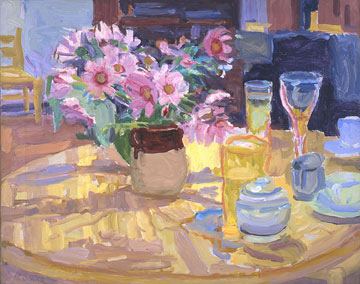
Nell Blaine was born on July 10, 1922 in Richmond, Virginia, sickly and severely cross-eyed. When she was two her parents realized that she was extremely nearsighted and had her fitted with glasses. She recalled her excitement over suddenly being able to see the world around her as she rushed around exclaiming “water, tree, and house.” The early visual handicap may well be at the root of the joy she took in the visual world. Blaine’s father, Harry Wellington Blaine, who had been previously married and even after Nell was born he continued to mourn his first wife, who had died in childbirth. His anger would kindle towards his daughter in the form of verbal and often physical abuse. His second wife, Eudora Catherine Garrison, had taught grade-school for ten years before the Nell’s birth. Garrison tutored Nell for a year when her health was too fragile to attend school.
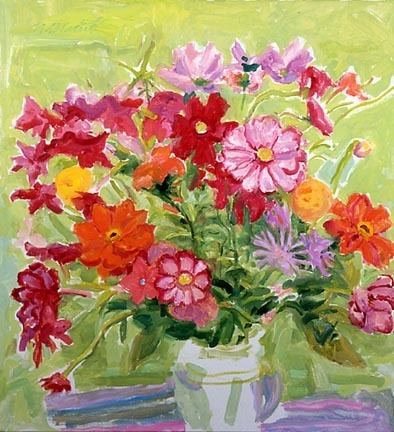
Blaine’s father lost his job as a lumber inspector, and had to settle for lesser pay during the Depression. This misfortune caused her grandfather to move in with them in the already crowded space. Nevertheless, she loved her grandfather and recalled that he loved to dance, could crack jokes, and told brilliant stories. Nell was made fun of when she started school because one of her eye turned in towards her nose, but she often defended herself with her fist. She was a pale and undernourished child; her school had to place her in a special class and on a strict diet. Because of her condition she had special nap times and more outdoor activities than the average child. Blaine’s crossed eyes were corrected after visiting her Aunt Nellie Sue and family in Baltimore. It took several operations at Johns Hopkins Hospital, along with months of wearing bandages. Being thirteen years of age was a big turning point in her life, both with her new vision and a warmer welcome from her peers at school.
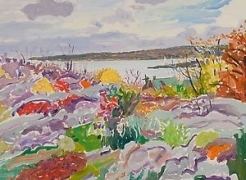
Nell Blaine’s drawing skills improved greatly because of the surgery, and she could recall telling her mother at the age of five that she has a desire to draw and make art. Her cousin Ruth bought her her first set of watercolor paints, and Nell was intrigued by its movement on paper. But Nell’s teenage life was not without problems stemming from the illness of her father. Her father suffered from cardiac asthma and a series of heart attacks that left him disabled and on oxygen for long periods. Nell’s only escape came with her summer trips to Baltimore to Nellie Sue’s house. However it was on one of these trips that the news came of her father’s passing.
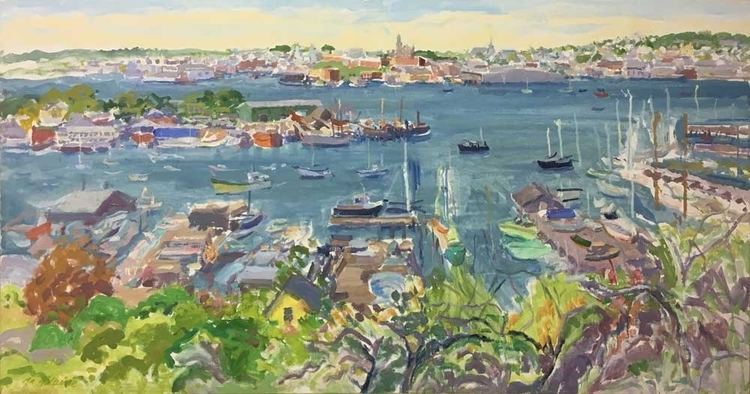
Flowers were Blaine’s happiest enduring link with her childhood in Richmond, Virginia. She recalled, “We lived in a small, plain house that my father built himself in a middle-class neighborhood, and the upper half was rented out so our space was very cramped. In the yard my mother, my father, and I each had a garden. My mother’s taste inclined to roses and spring flowers, and I had ordinary things like Zinnias and bluets, but the glory of our yard was my father’s dahlias. They bloomed in wonderful, brilliant colors, and the blossoms were as large as dinner plates. I remember the care with which he sorted the bulbs and stored them in the basement over the winter”.
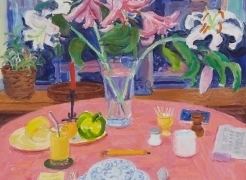
Blaine studied at the Richmond School of Art (now VCU) with Theresa Pollak. In 1942, she moved to New York City to study painting under Hans Hofmann to whom she was connected by printmaker Worden Day. Through her yearlong training at the Hans Hofmann School, she adopted a non-painterly style. By 1943, she joined the American Abstract Artists group as its youngest member. Blaine studied etching and engraving with Stanley William Hayter at Atelier 17 starting in 1945.
Early career
Blaine's work had begun as "tightly realist" but transformed to an abstract style, which was inspired by artists such as Piet Mondrian, Fernand Leger, and Jean Helion. Blaine's association with the American Abstract Artists group led to her receiving her first solo exhibition, held at Greenwich Village's Jane Street Gallery, of which she was a founding member and was home to the earliest known artists' cooperative in New York. In these early years with the Jane Street Group, Blaine prescribed to an abstract style, later explaining, "[By 1944], I'm developing so fast in my tastes and I become more abstract all the time--to the point of great purification....", and about fellow Jane Street Group members, "[we] were very dogmatic about our program. Now, as I look back on it, I'm a little ashamed. But we were so excited we really thought that was the gospel, you know. When you're young you are very sure of yourself. Blaire and many other young artists utilized the space to display and sell their works, raising funds from collectors and donors in New York and making a name for themselves through shared and solo exhibitions. At this time, Blaire was working alongside Ida Fischer, Judith Rothschild, and other Abstract Expressionist artists under 25 years of age.
Blaine briefly lived and worked in Paris around 1950 with Larry Rivers, traveling across Europe and exhibiting with the American Abstract Artists group in France, Denmark, and Italy. This experience inspired her to try traditional 19th century European painting. She showed at the Tibor de Nagy Gallery starting in 1953.
During the mid-1950s, she refined her increasingly painterly and colorful style. She worked directly from nature, or still life, particularly focusing on the forms and hues of flowers. Also during this time, Blaine was prominent among a prestigious circle of New York artists and poets which included John Ashbery, Frank O'Hara, Kenneth Kock, Jane Freilicher, Leland Bell, Louisa Matthiasdottir, Robert De Niro Sr., and Rudy Burckhardt. In 1955, she designed the original logo of colomn heads and layout for weekly New York newspaper The Village Voice.
In 1959, she spent several months travelling and painting in Greece before contracting bulbospinal, or paralytic, polio while visiting Mykonos Island. After eight months in a New York hospital, she was told she would never paint again. Though she used a wheelchair the rest of her life, intensive physical therapy had rehabilitated the use of her hands by 1960, and from then she would use her left hand to paint with oils, and her right hand to sketch and work on watercolors.
Work
Blaine resisted classifying her work, which explored color and the interplay of light and shade. The subject matter was primarily landscapes of the Hudson River made from her apartment window, vases of flowers, still lifes, home interiors, or her garden at Gloucester, Massachusetts. She once said, "The artist needs a permissive atmosphere. I am not involved in impressionism, and I have turned from my former total abstract presentation. Mine are action paintings. I want to be surprised by what I am doing. An artist must be his own leader, no matter what direction he takes."
By the 1950s, Blaine's work had reached considerable acclaim in New York City. Art critic Clement Greenberg spoke highly of her work, Ad Reinhardt credited her work in 1947, and Peggy Guggenheim selected one of her pieces for a group exhibition at Art of This Century in 1945. As her practice continued, she began to experiment more with Abstract Expressionism, watercolor as a medium, and the repeating motif of a window view from an interior. By 1959, despite her depleted health, Blaine was frequently traveling, painting landscape scenes in the Caribbean, Europe, New England, and more. At this point, she had largely moved past her Abstract Expressionist phase, and into a more Modernist style. By the mid 1970s, she had settled in Gloucester, Massachusetts.
Blaine used her art as a vehicle for the expression of pain. From the start she saw painting as a means of celebrating life and conceived her role to be that of an orchestrator of forms and colors. Blaine would convey this sense of celebration in her early abstractions inspired by jazz, recent unfurling petals of dahlias, or cushiony zinnias that testify to the abundant small miracles of the commonplace. Blaine's work often expresses a sense of isolation. While Gloucester was obviously much more secluded than New York, the theme is visible in her early work as well. Much of her reclusive, personal style can be attributed to the intimate relationship between artist and nature, to which she was deeply in tune when living in rural Massachusetts. Blaine was known to paint in seclusion, often late at night when she could have the quiet setting she preferred.
Personal life
In 1943, Blaine married Bob Bass, a French horn player who introduced her to good friends in painters Larry Rivers and Jane Freilicher; Blaine and Bass divorced in 1949. She lived for many years in a large apartment and studio in the building at 210 Riverside Drive with her life partner, artist Carolyn Harris, and maintained a summer home in Gloucester. An extensive obituary of Ms. Blaine appeared in the New York Times on November 15, 1996.
Recognition
Blaine's works are included in the permanent collections of the Metropolitan Museum of Art, Whitney Museum of American Art, The Brooklyn Museum, National Academy of Design, Hirshhorn Museum and Sculpture Garden, National Museum of Women in the Arts, Rose Art Museum, Virginia Museum of Fine Arts, and the Museum of Contemporary Art.
The native Virginian artist received a Visual Arts Fellowships from the Virginia Museum of Fine Arts in 1943 and 1946, which supported her training in New York with Hofmann and Hayter respectively. Life magazine featured Blaine as one of five young American "women artists in ascendance" in their May 13, 1957 issue.
In 1973, the Virginia Museum of Fine Arts honored Blaine with a solo exhibition that surveyed over a decade of her work. In 1980, Blaine was elected into the National Academy of Design as an associate member, and became a full member in 1982. Her papers are held at Harvard University. In 1986, Blaine received the Lifetime Achievement Award from the Women's Caucus for Art.
Exhibitions
1998
1987
1985
1973
1960
1948
1945
